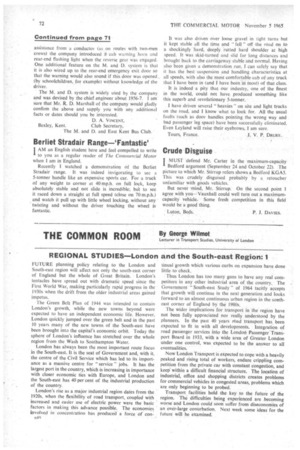REGIONAL STUDIES—London and the South-east Region: 1
Page 74

If you've noticed an error in this article please click here to report it so we can fix it.
FUTURE planning policy relating to the London and South-east region will affect not only the south-east corner of England but the whole of Great Britain. London's tentacles have spread out with dramatic speed since the First World War, making particularly rapid progress in the 1930s when the drift from the older industrial areas gained impetus.
The Green Belt Plan of 1944 was intended to contain London's growth, while the new towns beyond were expected to have an independent economic life. However. London quickly jumped over the green belt and in the past 10 years many of the new towns of the South-east have been brought into the capital's economic orbit. Today the sphere of London's influence has stretched over the whole region from the Wash to Southampton Water.
London has always been the most important route focus in the South-east. It is the seat of Government and, with it, the centre of the Civil Service which has led to its importance as a massive centre for " service" jobs. It has the largest port in the country, which is increasing in importance with closer economic ties with Europe, and London and the South-east has 40 per cent of the industrial production of the country.
London's rise as a major industrial region dates from the 1920s, when the flexibility of road transport, coupled with increased and easier use of electric power were the basic factors in making this advance possible. The economies involved in concentration has produced a force or con=
tinual growth which various curbs on expansion have done little to check.
Thus London has too many guns to have any real competitors in any other industrial area of the country. The Government "South-east Study of 1964 tacitly accepts that growth will continue in the next generation and looks forward to an almost continuous urban region in the southeast corner of England by the 1980s.
The wider implications for transport in the region have not been fully appreciated nor really understood by the planners. In the past 40 years ',bad transport has been expected to fit in with all developments. Integration of road passenger services into the London Passenger"Transport Board in 1933, with a wide area of Greater London under one control, was expected to be the answer to all eventualities.
Now London Transport is expected to cope with a heavily peaked and rising total of workers, endure crippling competition from the private car with constant congestion, and keep' within a difficult financial structure. The location of industrial, office and shopping districts creates problems for commercial vehicles in congested areas, problems which are only beginning to be probed.
Transport facilities hold the key to the future of the region. The difficulties being experienced are becoming worse" and London could soon suffer from diseconomies of art over-large conurbation. Next week some ideas for the future will be examined.




















































































































